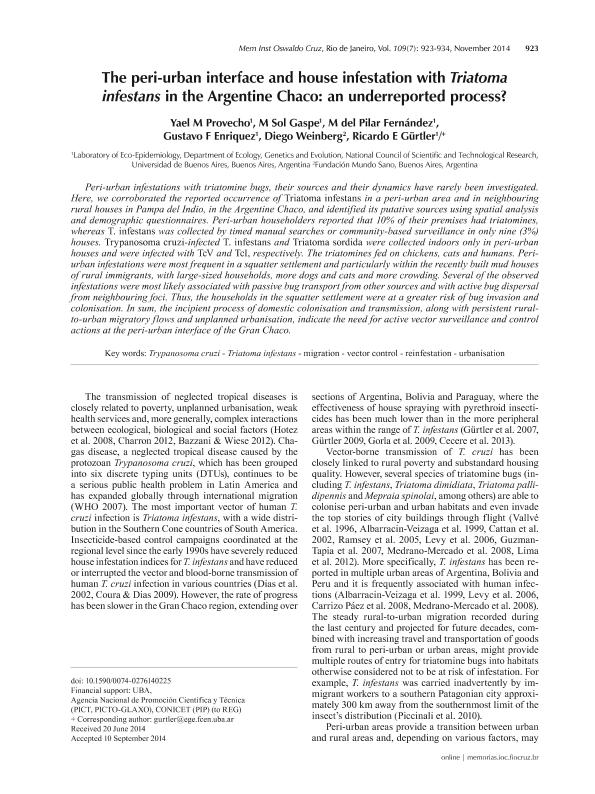Mostrar el registro sencillo del ítem
dc.contributor.author
Provecho, Yael Mariana

dc.contributor.author
Gaspe, Maria Sol

dc.contributor.author
Fernandez, Maria del Pilar

dc.contributor.author
Enriquez, Gustavo Fabián

dc.contributor.author
Weinberg, Diego
dc.contributor.author
Gurtler, Ricardo Esteban

dc.date.available
2017-12-27T21:11:04Z
dc.date.issued
2014-11
dc.identifier.citation
Gurtler, Ricardo Esteban; Weinberg, Diego; Enriquez, Gustavo Fabián; Fernandez, Maria del Pilar; Gaspe, Maria Sol; Provecho, Yael Mariana; et al.; The peri-urban interface and house infestation with Triatoma infestans in the Argentine Chaco: an underreported process?; Fundacao Oswaldo Cruz; Memórias do Instituto Oswaldo Cruz; 109; 7; 11-2014; 923-934
dc.identifier.issn
0074-0276
dc.identifier.uri
http://hdl.handle.net/11336/31761
dc.description.abstract
Peri-urban infestations with triatomine bugs, their sources and their dynamics have rarely been investigated. Here, we corroborated the reported occurrence of Triatoma infestans in a peri-urban area and in neighbouring rural houses in Pampa del Indio, in the Argentine Chaco, and identified its putative sources using spatial analysis and demographic questionnaires. Peri-urban householders reported that 10% of their premises had triatomines, whereas T. infestans was collected by timed manual searches or community-based surveillance in only nine (3%) houses. Trypanosoma cruzi-infected T. infestans and Triatoma sordida were collected indoors only in peri-urban houses and were infected with TcV and TcI, respectively. The triatomines fed on chickens, cats and humans. Peri-urban infestations were most frequent in a squatter settlement and particularly within the recently built mud houses of rural immigrants, with large-sized households, more dogs and cats and more crowding. Several of the observed infestations were most likely associated with passive bug transport from other sources and with active bug dispersal from neighbouring foci. Thus, the households in the squatter settlement were at a greater risk of bug invasion and colonisation. In sum, the incipient process of domestic colonisation and transmission, along with persistent rural-to-urban migratory flows and unplanned urbanisation, indicate the need for active vector surveillance and control actions at the peri-urban interface of the Gran Chaco.
dc.format
application/pdf
dc.language.iso
eng
dc.publisher
Fundacao Oswaldo Cruz

dc.rights
info:eu-repo/semantics/openAccess
dc.rights.uri
https://creativecommons.org/licenses/by-nc-sa/2.5/ar/
dc.subject
Periurban
dc.subject
Infestation
dc.subject
T. Infestans
dc.subject.classification
Otras Ciencias Biológicas

dc.subject.classification
Ciencias Biológicas

dc.subject.classification
CIENCIAS NATURALES Y EXACTAS

dc.title
The peri-urban interface and house infestation with Triatoma infestans in the Argentine Chaco: an underreported process?
dc.type
info:eu-repo/semantics/article
dc.type
info:ar-repo/semantics/artículo
dc.type
info:eu-repo/semantics/publishedVersion
dc.date.updated
2017-12-27T15:19:00Z
dc.identifier.eissn
1678-8060
dc.journal.volume
109
dc.journal.number
7
dc.journal.pagination
923-934
dc.journal.pais
Brasil

dc.description.fil
Fil: Provecho, Yael Mariana. Universidad de Buenos Aires. Facultad de Ciencias Exactas y Naturales. Departamento de Ecología, Genética y Evolución. Laboratorio de Eco - Epidemiología; Argentina. Consejo Nacional de Investigaciones Científicas y Técnicas; Argentina
dc.description.fil
Fil: Gaspe, Maria Sol. Universidad de Buenos Aires. Facultad de Ciencias Exactas y Naturales. Departamento de Ecología, Genética y Evolución. Laboratorio de Eco - Epidemiología; Argentina. Consejo Nacional de Investigaciones Científicas y Técnicas; Argentina
dc.description.fil
Fil: Fernandez, Maria del Pilar. Universidad de Buenos Aires. Facultad de Ciencias Exactas y Naturales. Departamento de Ecología, Genética y Evolución. Laboratorio de Eco - Epidemiología; Argentina. Consejo Nacional de Investigaciones Científicas y Técnicas; Argentina
dc.description.fil
Fil: Enriquez, Gustavo Fabián. Universidad de Buenos Aires. Facultad de Ciencias Exactas y Naturales. Departamento de Ecología, Genética y Evolución. Laboratorio de Eco - Epidemiología; Argentina. Consejo Nacional de Investigaciones Científicas y Técnicas; Argentina
dc.description.fil
Fil: Weinberg, Diego. Fundación Mundo Sano; Argentina
dc.description.fil
Fil: Gurtler, Ricardo Esteban. Universidad de Buenos Aires. Facultad de Ciencias Exactas y Naturales. Departamento de Ecología, Genética y Evolución. Laboratorio de Eco - Epidemiología; Argentina. Consejo Nacional de Investigaciones Científicas y Técnicas; Argentina
dc.journal.title
Memórias do Instituto Oswaldo Cruz

dc.relation.alternativeid
info:eu-repo/semantics/altIdentifier/url/http://ref.scielo.org/3z7gc6
dc.relation.alternativeid
info:eu-repo/semantics/altIdentifier/url/https://www.ncbi.nlm.nih.gov/pmc/articles/PMC4296498/
dc.relation.alternativeid
info:eu-repo/semantics/altIdentifier/doi/http://dx.doi.org/10.1590/0074-0276140225
dc.relation.alternativeid
info:eu-repo/semantics/altIdentifier/url/http://memorias.ioc.fiocruz.br/issues/past-issues/item/2096-0225_the-peri-urban-interface-and-house-infestation-with-triatoma-infestans-in-the-argentine-chaco-an-underreported-process?
Archivos asociados
